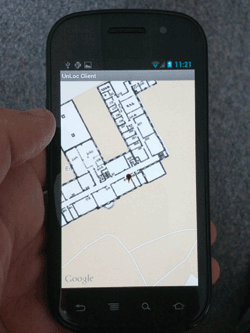Indoor localization app uses ‘invisible’ landmarks
A team of researchers from Duke University (Durham, NC) recently demonstrated a precise indoor localization application named UnLoc, short for unsupervised indoor localization. The ability to achieve precise indoor localization can open up a host of mobile apps, according to Romit Roy Choudhury, associate professor of computer engineering at Duke’s Pratt School School of Engineering and principal investigator for the Duke research team.

The Duke’s technique takes advantage of “‘invisible”’ landmarks in indoor environments that a mobile phone can findsense using its built-in sensors.
GPS has been a successful technology for positioning users in outdoor environments, but for indoor use it has not been accurate. During the last few years Google, Microsoft, Qualcomm, and Apple, as well research teams at universities have focused on indoor localization.
The Duke team’s idea for precise indoor localization is analogous to how we use landmarks outdoors. For example, say Alice is in Bob’s neighborhood and calls for directions. She lets Bob know she is near a known fountain so Bob can give her directions from there. Duke’s method uses “invisible” landmarks in indoor environments that a mobile phone can find using built-in sensors. These landmarks could be distinct motion signatures created by elevators or stairwells, since the phone can detect motion, or certain dead spots where Wi-Fi or 3G signals are absent.
Once an invisible landmark is sensed, the phone can infer its current location. It then tracks its path from that point forward using motion sensors, such as gyroscopes, compasses, and accelerometers. Over time, the tracking may become inaccurate, but the phone can correct its location as it passes other landmarks.
The details of this system was presented at the 10th ACM International Conference on Mobile Systems, Applications, and Services in Low Wood Bay, U.K.
UnLoc does not require any pre-deployment effort, in which every location needs to be visited and calibrated to create a database of per-location fingerprints. This can be very expensive since it needs to be done periodically. Also UnLoc has be shown to be less battery-hungry than GPS. Since smartphones use energy-efficient inertial sensors, the user can track locations continuously.
The application has been tested in the Northgate shopping mall in Durham, NC, and in the science and engineering building on Duke’s campus. During these tests, UnLoc was able to achieve 1.6-m accuracy on average. “Further improvement is feasible by learning more landmarks and improving the tracking algorithms,” said Alex Mariakakis, a Duke student involved in this project.
Christina Nickolas
Advertisement
Learn more about Duke University





